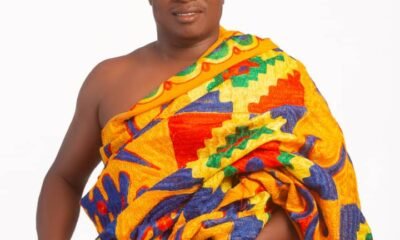News
Dr. Prempeh: A trustworthy ‘servant’ of Manhyia South

• The library is named after the late Ashanti Queen, Nana
Afia Kobi Serwaa Ampem II
At a time that some Members of Parliament (MPs) are going through a huge crisis because of the disconnect between them and their constituents, one MP who is enjoying a peaceful relationship and an unflinching support from his area is the MP for Manhyia South Constituency, Dr. Matthew Opoku Prempeh.

There is a strong bond between the MP and the Manhyia Palace as well as the electorate because of his unique posture of seeing himself as the servant of the people as he consults and listens to them always.
Since 2009 that he first entered Parliament, Dr. Prempeh has been there for the good people of Manhyia South, and they have also been there for him.
Napo, as Dr. Prempeh is affectionately called, has delivered so well that it does not surprise the people of Manhyia South to wake up in the morning to see another development project commencing.
The MP recently mesmerised the Manhyia Palace with an ultra-modern library located at Ashtown and named after the late Ashanti Queen, Nana Afia Kobi Serwaa Ampem II.
The 200-seater edifice boasts of free wifi, 36 computers and other modern amenities to promote easy learning by students and the public.
The one-storey library project has been stocked with some 10,000 books for its patrons, especially students, to study and acquire new knowledge.
The decision by Dr. Prempeh to honour the late Ashanti Queen posthumously was to appreciate the key roles she played in promoting education in the Ashanti Region and beyond during her reign.
The MP, who is also a former education minister, during the commission of the project, said that he decided, together with the people of the area, to name the library after the late Queen to honour her for her good works for the country and also to motivate others to emulate her.
Napo, who is a royal from Apagyafie, entreated the youth of the area and Kumasi to constantly visit the library and add to their knowledge, adding it was only through education that the gap between the rich and the poor in society could be narrowed.
The land for the project was provided by the Asantehene. Otumfuo Osei Tutu II, who is the first born of the late Nana Afia Kobi Ampem II.
Traditional rulers who were present at the event at the behest of the Manhyia Palace were full of praises to Dr. Prempeh for his understanding of the importance of education and his readiness to promote same in the area.
What is more striking is the fact that at no point did Dr. Prempeh mention the quantum of money spent on the project in honour of the late Ashanti Queen.
Mindful of the role of the youth in development, Dr. Prempeh, in June this year, rolled out a youth entrepreneurship empowerment project in the constituency to tackle youth unemployment by equipping them with the needed training skills to employ themselves and their families.
The project, dubbed “Reducing unemployment through skills training,’’ in partnership with the College of Beauty and Arts and Entrepreneurship (CBAE), started on June 27, this year.
Some 80 trainees selected from the six electoral areas within the Manhyia South Constituency have been equipped in Make-Up Artistry, Beauty Technology and Fashion Design Technology training for seven weeks.
What is unique is that Dr. Prempeh took care of all the equipment needed for the seven weeks’ training programme and start-up equipment, as well.
The youth of Manhyia South who were enthused about the magnanimity of the MP have vowed to take advantage of the skills training agenda and start up their own businesses.
The Chief of Kokoso, in the Ashanti Region, Nana Kwaku Duah, who was at the launch of the programme, advised the youth to embrace the opportunity with a high sense of seriousness for the betterment of their future.
Nana Kwaku Duah would not stop praising Dr. Prempeh for empowering the youth of Manhyia South, saying: “The electorate will always remember him for his good works.”
One thing that makes the people happy is the fact that their MP does not singlehandedly decide the kind of projects they should have, rather, he involves the people to take decisions on what would inure to their collective benefit.
Dr. Prempeh, who is the current energy minister, in his own way since becoming the MP for Manhyia South, has delivered beyond expectation and it is not out of nothing that the chiefs, opinion leaders, school children and the youth across the political divide see him as a trustworthy servant of the area.
By Godfred Opare Djan
News
Promoting Peace and Unity: Minister for the Interior Meets Muslim

Minister for the Interior, Muntaka Mohammed-Mubarak, has assured Muslim leaders and Zongo Chiefs in Kumasi of his continued partnership and open-door policy to maintain peace and security in the Ashanti Region.
Speaking during a sensitization workshop on promoting peace, social cohesion and addressing security concerns, the Minister emphasised the importance of collaboration between Government and religious leaders.
Muntaka Mubarak who is also the Member of Parliament for the Asawase constituency, acknowledged the growing threat of drug abuse in Ghana and urged Muslim leaders to partner with Government to tackle the root causes of drug abuse in the communities.
The Minister also highlighted the need to address vigilantism, land guard activities, chieftaincy disputes and other threats to national security.
He expressed confidence that united, they can rise above the challenges and promote peace and social cohesion in Kumasi and beyond.
The meeting was attended by various sects in the region including The Ghana Muslim Mission, Zongo Traditional Council Palace, Ahli Sunnah, Council of Zongo Chiefs, Council of Ulama.
News
Let us collaborate to strengthen security in Ghana- Muntaka urges Christian Religious Leaders

The Minister for the Interior, Muntaka Mohammed Mubarak has called for strengthening of security in the country through collaboration.
He highlighted the crucial role of collaboration between the government and religious leaders in promoting peace, social cohesion and security across Ghana.
In an engagement with the Christian Religious Leaders in Kumasi, Muntaka Mubarak acknowledged that maintenance of Peace and security in the country is a collective responsibility hence the need for engagement with key stakeholders to share ideas to promote peace and security.
‘Your influence in fostering peace and unity is invaluable. I urge you to continue preaching messages of love, forgiveness and hope from your pulpits. Together, we can create a Kumasi and indeed a Ghana that is safer, healthier and more secure for all,’ he stated.
The Minister acknowledged the growing concern of drug abuse in the country, which threatens communities and endangers youth. He urged Christian leaders to continue preaching messages of love, forgiveness, and hope, while also supporting initiatives that offer treatment and rehabilitation to those in need.
He sought partnership in bolstering the Ghana Prisons Service and Ghana National Fire Service to enable them address challenges like overcrowding and inadequate infrastructure.
Muntaka Mubarak commended Christian bodies for their support, particularly the Church of Pentecost, which has built modern facilities to equip inmates with trades like farming and tailoring.
The Minister reaffirmed his commitment to collaborating with Christian leaders, ensuring an open-door policy to foster peace and understanding.
This partnership aims to promote social cohesion and security, recognizing the vital role religious leaders play in maintaining harmony within communities.
The meeting was attended by the Ashanti Region representatives of the Christian Council, the Ghana Pentecostal and Charismatic Council, the Catholic Archdiocese and the National Association of Christian and Charismatic Churches amongst others.







